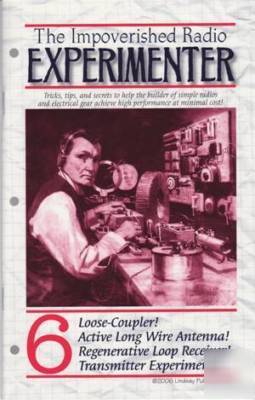Wisconsin Parts Database Instructions and Discussion Team/Group > ILLINOIS
> Motors and tools
> Remove
> New
> Impoverished radio experimenter vi - how to book
Impoverished radio experimenter vi - how to book
Tricks, tips, and secrets to help the builder of simple radios and electrical gear achieve high performance at a minimal cost!
Build a loose coupler. It's a very early form of a doubly-tuned RF transformer - like an IF transformer but with variable coupling. If you haven't tried one on a crystal set, you should, especially if you live in an area where you have many AM radio stations. This device won't make your crystal set louder (only a longer antenna can do that), but it will improve selectivity.
You build a loose coupler from cardboard tubes and sheets of cardboard. It's easy. Also included is a reprint of a construction article from a 1911 issue of Electrician & Mechanic Magazine that will show you how to build a fancy coupler just like the spark boys once used.
Then it's on to another power supply. Here, you'll learn how to use a commonly available transformer to get high voltage for vacuum tube plates. But the real beaut is the simple, low-cost regulator that will turn any power supply into a rock-solid performer. You can put the regulator on your existing supply and dial in just about any voltage you want. And that voltage won't change whether you draw 2 mA or 400! It's great for receivers but has the capacity to handle sizable tube transmitters as well.
Next, build a loop antenna. Several are shown. Attach the simple, low-cost two-transistor amplifier, and you have an artificial long wire. If you live in an apartment or have a small lot, this loop antenna can simulate a long wire and allow you to experiment with crystal sets. It's cheap but really performs.
Next, I'll show you how I took a loop antenna and turned a basic Franklin oscillator circuit into a regenerative receiver for the AM broadcast bands and lower. The receiver and antenna are simple to build and perform remarkably well. With the sensitivity of the regen receiver and the directivity of the loop I was able to pull in very weak stations 80 miles away in daylight from my basement. I was able to take the same receiver down to 60 khz to hear WWVB's digital time carrier from Colorado.
You get details on how to take almost any oscillator circuit and turn it into a receiver by attaching the necessary filters that sort out the various signals.
Finally, you get some notes on amateur band code transmitters. QST has been filled with construction articles for decades, and you'll get a list of several that I think are among the best as far as simplicity and performance are concerned. Also provided are some schematics and basic information on single tube transmitters I was able to build in a matter of minutes and put on the AM band. You can do it, too.
More simple radio fun. You don't need thousands of dollars of equipment to have fun with radio. In fact, amateur radio has always been preoccupied with getting the most performance for the fewest dollars. Volume Six will show you how to do it today. With tubes.

